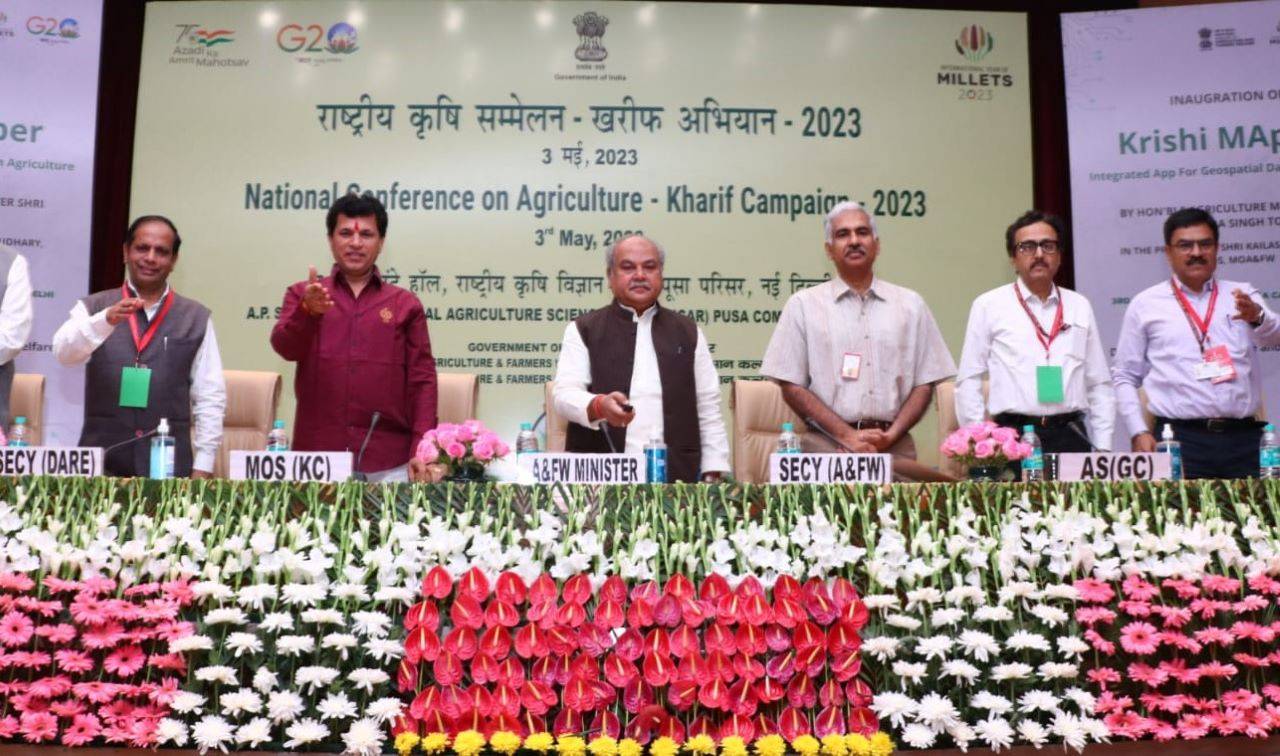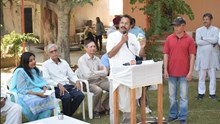
During his speech at the conference, Tomar highlighted that agriculture remains a crucial driver of the Indian economy and is fundamental to the nation's socioeconomic development. This sector contributes to around 19% of the country's GDP and provides employment to nearly two-thirds of the workforce.
Tomar expressed satisfaction that India's agriculture sector had grown rapidly over the last six years, with an average annual growth rate of 4.6%. This has enabled agriculture and allied activities to make major contributions to the country's overall growth, development, and food security. According to the 2nd Advance Estimates (2022-23), the country's foodgrain production is expected to be 3235 lakh tonnes, which is 79 lakh tonnes more than the production in 2021-22.
Rice, maize, gramme, pulses, rapeseed and mustard, oilseeds, and sugarcane production are expected to set new records. Total sugarcane production in the country is expected to reach a record 4688 lakh tonnes in 2022-23, which is 1553 lakh tonnes more than the average sugarcane production. According to the 3rd Advance Estimates of Horticulture, a record 3423.3 lakh tonnes of horticultural production is expected in 2021-22, representing a 77.30 lakh tonnes increase over production in 2020-21.
The goal of this conference was to review and assess crop performance in previous crop seasons, set crop-specific targets for the Kharif season in consultation with state governments, ensure the supply of critical inputs, and facilitate the adoption of innovative technologies in order to increase crop production and productivity. The government's top objective is agro-ecological crop planning to redirect land from surplus commodities like rice and wheat to deficit commodities like oilseeds and pulses, as well as high-value export crops.
During Rabi 2020-21, a special Mustard project was launched, yielding outstanding results. In the last three years, mustard production has increased by 40%, from 91.24 to 128.18 lakh tonnes. Productivity increased by 11%, from 1331 to 1447 kg/ha. From 68.56 lakh ha in 2019-20 to 88.58 lakh ha in 2022-23, the area under rapeseed and mustard increased by 29%. This incredible achievement was made possible by timely action by both the federal and state governments.
The Minister stated that India will hold the Global Millets (Shree Anna) Conference on March 18, 2023, at the IARI campus in PUSA, New Delhi, as part of the big celebration of the International Year of Millets. The Prime Minister unveiled a commemorative coin and stamp commemorating the International Year of Millets (IYM) 2023, followed by the digital introduction of a book of millets (Shree Anna) standards.
The Prime Minister designated ICAR-IIMR as a Global Centre of Excellence, and a short film about Shree Anna and IYM 2023 was screened. By organizing monthly meetings (in person/video conference) with all stakeholders, the Ministry of Agriculture and Farmers Welfare ensures that IYM is honoured in a systematic manner throughout the year. Expert institutes such as ICAR-IIMR, APEDA, ICRISAT, and others are also participating to promote R&D, productivity, and value addition.
The Conference established national production targets for foodgrains and other commodities. The national aim for total food grain production in 2023-24 is 3320 lakh tonnes. The target for pulse output has been set at 292.5 lakh tonnes, up from 278.1 lakh tonnes this year, and oilseed production will be boosted from 400 to 440 lakh tonnes in 2023-24. Total Shree Anna output must be increased from 159.1 million tonnes in 2022-23 to 170.0 million tonnes in 2023-24. In poor yielding locations, the aim would be to increase area by intercropping and crop diversity, while increasing productivity through the introduction of HYVs and the adoption of appropriate agronomic practices.
Speaking at the conference, Kailash Choudhary, MoS (Agriculture and Farmers Welfare), expressed hope that global demand for millets will increase as a result of the designation of 2023 as the International Year of Millets (IYM). This will provide us with a unique opportunity to increase production, ensure efficient processing and consumption, promote better crop rotations, and encourage better connectivity throughout food systems to promote millets as a kefir.
Millets have the potential to contribute significantly to economic and ecological diversification, climatic resilience, and food and nutritional security due to their multifunctionality. Millets, often known as "Smart Food" or "Nutri-Cereals," play an important part in altering agri-food systems around the world. India is on its way to become an international hub for millets. During his consideration, he stated that while there has been a notable growth in oilseeds and pulses, more emphasis should be placed on further increasing seed and pulse production. All government facilities, schemes, and agricultural information must be provided through FPO for optimal execution.
According to Manoj Ahuja, Secretary (Agriculture & Farmers Welfare), the country's food grain production has been improving since 2015-16. The government has taken steps to increase crop and livestock productivity, ensure farmers' certainty of returns through price support (Minimum Support Price), promote crop diversification, and has made targeted interventions to improve credit availability, facilitate mechanization, and boost horticulture and organic farming.
As a result, agricultural exports are expected to reach an all-time high in 2021-22. In comparison to the previous year 2020-21, agri and allied exports increased by 19.99%, from 41.86 billion USD in 2020-21 to 50.24 billion USD in 2021-22. To help farmers and modernize agriculture, the government launched the SATHI (Seed Traceability, Authentication, and Holistic Inventory) Portal and Mobile App, a centralized online system for seed traceability, authentication, and inventory designed to address seed production, quality seed identification, and seed certification challenges.
Furthermore, he stated that in order to combat adverse weather conditions, a single window advisory system should be implemented for issuing weather-related issues to farmers. As a result, agricultural exports are expected to reach an all-time high in 2021-22. In comparison to the previous year 2020-21, Agri & allied exports increased by 19.99%, from 41.86 billion USD in 2020-21 to 50.24 billion USD in 2021-22.
To help farmers and modernize agriculture, the government launched the SATHI (Seed Traceability, Authentication, and Holistic Inventory) Portal and Mobile App, a centralized online system for seed traceability, authentication, and inventory designed to address seed production, quality seed identification, and seed certification challenges. Furthermore, he stated that in order to combat adverse weather conditions, a single window advisory system should be implemented for issuing weather-related issues to farmers. During his consideration, he recommended farmers to adopt organic inputs on the PM PRANAM and PM Kisan Samridhi Kendra.
Dr. Himanshu Pathak, Secretary (DARE) and Director General, ICAR, shared recent technological developments in agriculture for the benefit of states, as well as plans for development. He emphasized the importance of employing bio-fortified and climate resilient varieties to realize the objective of food and nutritional security for everybody. In addition, he has stated that for the advancement of climate resilient kinds, freshly released and bio fortified types should be adopted. Detailed presentations were given by the Additional Secretary (Fertilizers) on the state of fertilizer delivery, the Agri stack for agricultural digitization by the Additional Secretary (agricultural), and financial issues released by the Additional Secretary and financial advisor. JS (Crops) gave a presentation on Kharif season prospects and strategy.
The state principal secretaries of Maharashtra, Jharkhand, and Odisha presented their Kharif preparation and execution strategies. Pradhan Mantri Fasal Presentation The CEO of PMFBY announced the Bima Yojana, and then the Joint Secretaries of Drought Management, RKVY Annual Action Plan, and Digital Extension plans were discussed in detail.
The National Conference was attended by the Additional Secretary (Agriculture), top officers from DA&FW, ICAR, and officers from several state governments. This was followed by a discussion with Agriculture Production Commissioners and Principal Secretaries from all states about how to increase area coverage, production, and productivity during the Kharif season in 2023.
















